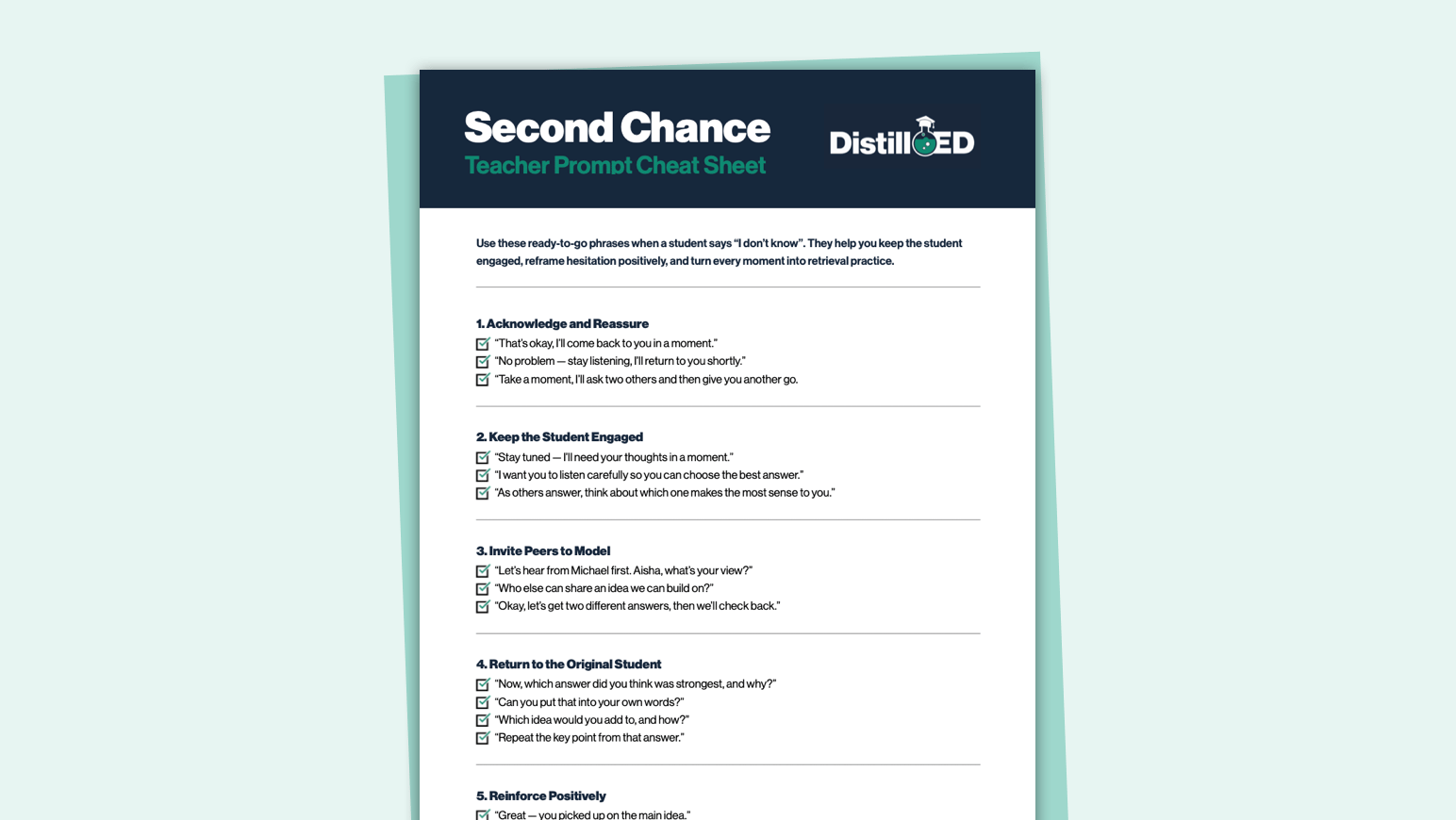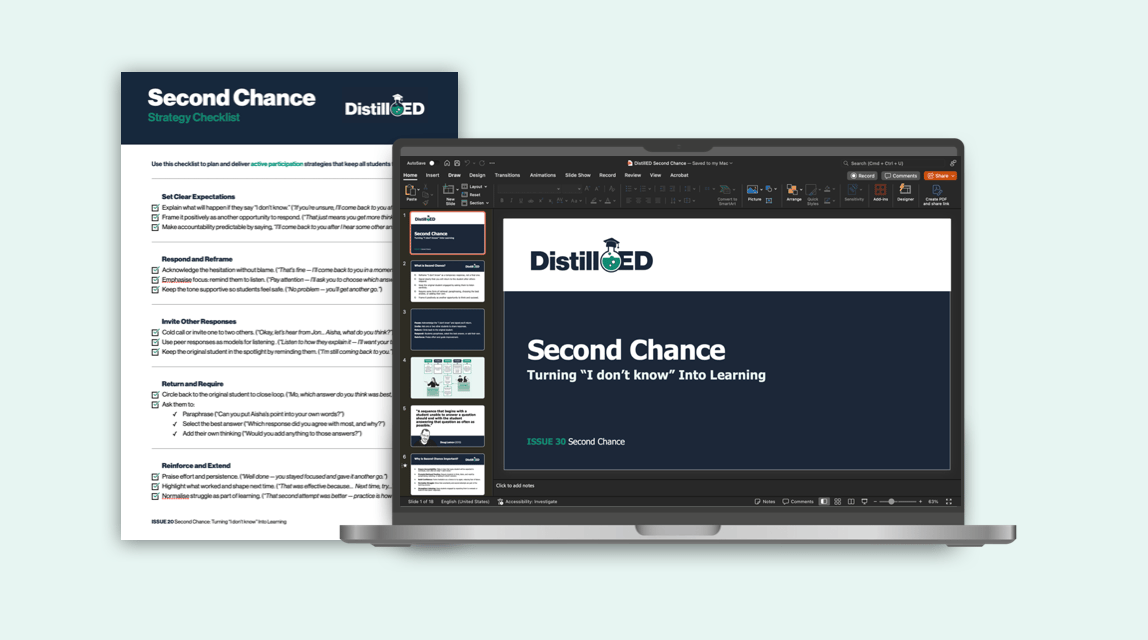👋 Hey hey {{first name | friend!}}
Every teacher has heard it: “I don’t know.” But instead of treating it as a dead end, we can turn that moment into an opportunity.
In this edition of ⚗️DistillED, we explore the Second Chance strategy—sometimes known as No Opt Out (Doug Lemov, Teach Like a Champion)—a simple but powerful way to keep students accountable, build confidence, and strengthen classroom culture.

What is Second Chance?
Second Chance is a questioning strategy where a student’s “I don’t know” doesn’t end the conversation. Instead, the teacher signals that they'll return shortly, inviting others to respond first. Once an answer is given or a meaningful cue is offered, the teacher circles back to the original student and asks them to repeat or paraphrase that response—or even select the best answer and explain why or add their own reasoning.
“A sequence that begins with a student unable to answer a question should end with the student answering that question as often as possible.”
In a nutshell, the process is illustrated in the diagram and plays out like this:
Pause: Acknowledge the “I don’t know” and signal you’ll return.
Invite: Ask one or two other students to share responses.
Return: Circle back to the original student.
Respond: Have them paraphrase, select the best answer, or add their own.
Reinforce: Praise effort and guide improvement.

So why is this so important? Let’s dip our toes into the research…
Why is the Second Chance strategy effective?
Questioning is one of the most frequent features of classroom teaching—Brualdi (1998) found that teachers ask more than 300 questions per day! With questioning so central to learning, strategies like Second Chance become vital for ensuring all students are thinking and contributing.
Research into classroom questioning and formative assessment shows that students learn best when participation is expected and mistakes are reframed as part of learning. By returning to a student after they initially say “I don’t know,” teachers make it clear that thinking cannot be avoided and that every learner will be supported to contribute.
Essentially, this strategy reinforces the message that every student is expected to think, participate, and be given another shot at success. It builds:
Accountability: Keeps every student engaged and responsible for answering
Opportunity: Frames hesitation as a chance to try again
Confidence: Builds success through supported second attempts
Resilience: Normalises struggle as part of learning
Attention: Strengthens listening to peers and teacher
Cognitive science strengthens this case. Learning requires active thought, and as Daniel Willingham reminds us, “Memory is the residue of thought.” Second Chance ensures that students keep thinking—listening to peers, evaluating responses, and formulating their own ideas—so that the act of engaging becomes the act of learning.
“Students remember what they think about... Memory is the residue of thought”
As we know, retrieval practice—the act of generating an answer—strengthens memory and supports long-term retention. The Second Chance strategy ensures that even students who begin with “I don’t know” are drawn into this process. By requiring them to listen, reflect, and then contribute, hesitation is transformed into retrieval practice, giving every learner the opportunity to think harder and remember more.
So, how do we make sure that every “I don’t know” becomes a springboard for learning rather than a dead end?
Let’s find out.
DistillED+ PD Resources
Did you know, DistillED+ subscribers get instant access to exclusive PD resources such as new one-page guides, checklists and PowerPoint slides?
This recent guide on Exit Tickets is a prime example…It breaks down what exit tickets are, why they matter, and how to implement them effectively.

How do I implement Second Chance effectively?
To make the Second Chance strategy more effective, clarity and tone matter. Before adopting the 6 step approach below, address the following groundwork:
Set Expectations: Be explicit: “I’ll ask two more people, then come back and ask you which response you think is best.”
Frame Positively: Emphasise that it’s an opportunity: “I’ll give you a little more time and then come back to you.”
Don’t Blame: Avoid scolding. Instead: “That’s okay, but it’s important to stay focused so you learn. I’ll ask again shortly.”
Step | Explanation | Example |
|---|---|---|
1. Set Clear Expectations
| Explain that you’ll return to them after asking others, and that you’ll expect them to contribute by paraphrasing, selecting, or adding to an answer. | “If you’re unsure, that’s okay. I’ll ask two other students, then come back to you so you can tell me which answer you think is best and why.” |
2. Ask the Question
| Ensure your question is well-structured and prompts reasoning, not just recall. | “What theme is Shakespeare exploring in Lady Macbeth’s soliloquy here?” |
3. Respond to ‘I Don’t Know’
| Signal support and reassure them they’ll have another go. | “That’s fine—stay listening. I’ll come back to you in a moment so you can have another try.” |
4. Invite Other Responses → Purpose: Provide models and keep the class engaged. | Ask one or two other students for their answers while the first student listens. | “Okay, let’s hear from Michael. Aisha, what do you think?” |
5. Return to the Original Student → Purpose: Ensure accountability by circling back. | Ask them to paraphrase, choose the best answer, or add their own thinking. | “Now, Mohammed—which answer did you think was strongest, and why?” |
6. Reinforce Positively → Purpose: Build confidence and guide improvement. | Acknowledge effort and encourage growth. | “Great—you picked up on the key idea. Next time, try adding an example from the text.” |
Remember, “I don’t know” doesn’t mean move on. Be patient, circle back, and give students the chance to retrieve, reflect, and grow. It’s in those second attempts that confidence is built and real learning sticks.
Until next time — keep questioning, keep coming back!
Jamie
Where can I find out more?
Second Chance Prompts Cheat Sheet
To support your use of the Second Chance strategy, I’ve put together a Teacher Prompts Cheat Sheet — a half-page printable with ready-to-use wording for every stage of the process.

Checklist and Slideshow
This week’s ⚗️DistillED+ resources are checklist and a CPD slideshow on the Second Chance strategy. Together, they cover the WHAT, WHY, and HOW of using “I’ll come back to you” to turn “I don’t know” into retrieval, accountability, and learning.
Upgrade to ⚗️DistillED+ to download the content.

Upgrade to DistillED+ to get this content!
Join DistillED+
Members gain access to expertly curated digital evidence-informed content
UPGRADEA ⚗️DistillED+ subscription gets you:
- Full access to new premium one-page guides
- Full access to evidence-informed strategy checklists
- Full access to slide templates (PowerPoint and Keynote)


